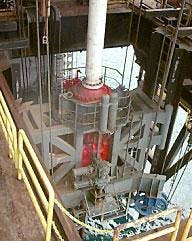Industry promotes surface BOPs for floating drilling operations
Offshore operators and drilling contractors are working to advance surface blowout preventer (BOP) technology for floating drilling operations (Figs. 1 and 2). The technology extends the capability of older and smaller drilling rigs and reduces deepwater oil and gas exploration and development costs.
The industry's effort to promote the technology encompasses well-construction issues, drilling-vessel upgrades and modifications, and health, safety, and environment (HSE) considerations.
The International Association of Drilling Contractors and the US Minerals Management Service hosted a 1-day workshop in Houston last month. The event allowed industry and regulators to present the technology's current state-of-the-art, review pending work, and highlight HSE issues related to surface BOP applications.
Unocal Corp., El Segundo, Calif., first applied the use of surface BOPs for floating drilling operations in 1996 in the mild-meteorological ocean conditions of Indonesia's Makassar Strait (OGJ, May 6, 2002, p. 65).
Using second-generation semisubmersible drilling rigs, the company used the concept to reduce the number and size of casing strings in its explorations wells (Fig. 3). With the lower resulting well costs, the company embarked on a multiple-well exploration program it called "saturation exploration."
Case for surface BOP
Compared to conventional subsea BOP operations, the surface BOP concept has a restricted range of field-proven applications. The industry is working to expand this envelope.
Paul Goodfellow, Shell Exploration & Production Co. (Sepco), Houston, presented the case for the industry to advance the technology, allowing its use in other geographic areas, in moderate-ocean climates, and for more demanding well and rig conditions.
He said, "Using larger and larger drilling rigs to explore and develop assets in deeper and deeper water is too expensive and needlessly [affects] the surround- ing environment given technologies that are currently being developed."
Fig. 4 shows that deepwater project development costs, relative to the Gulf of Mexico's first tension-leg platform, named Auger, have declined significantly during the past decade. Goodfellow said that industry experience, ingenuity, efficiencies, and the application of new technologies had driven the improvement.
He said that for deepwater project costs to continue declining, industry in the area would need something new such as surface BOPs for floating drilling operations.
Well costs are a key contributor to deepwater development costs and project economics.
Translating the technical well costs to dollars per barrel of oil price margin, Goodfellow explained that impacting well cost by 30% would have an effective $2/bbl impact on a deepwater project's net present value.
He said, "Surface BOPs is one of those key technologies that will allow [operators] to move [their] margins."
The physics of oil and gas exploration, development, and production are becoming more difficult. Goodfellow said exploration and development occur in deeper water, wells are becoming deeper, and operators must drill larger diameter wellbores to reach TD.
He also said that wells must produce from multiple zones, they could exist in high temperature and pressure areas, and there could be little difference between pore pressure and fracture gradient.
Goodfellow said, "If we are to continue that sustained reduction in costs and improvement in margins, then we [must] continue to develop and employ leading edgeUtechnologies. We have to retain skilled and competent people. If we can do all of this, I'm convinced that we can apply these new technologies in a safe manner."
Drivers, barriers
To benefit fully from cost advantages of smaller floating drilling rigs using surface BOPs and to drill and complete wells successfully in the offshore geopressured environment require technologies other than surface BOPs.
Goodfellow said expandable tubulars is the other key technology that, hand-in-hand with surface BOPs, would allow operators to use smaller rigs to drill smaller wells to exploit offshore oil and gas reserves.
Deepwater wellbore designs have followed a natural progression from the conventional wells drilled from drillships or fifth-generation semisubmersible rigs, using subsea BOP stacks and 21-in. risers, to the more slender well designs that employ expandable tubulars, 16-in. risers, and third-generation semisubmersible rigs.
Goodfellow said Sepco had successfully drilled the first well using MonoDiameter technology, this past summer in South Texas, which involved running successive 95/8-in. expandable-casing strings through each other (OGJ, Oct. 21, 2002, p. 53).
Important for offshore, he added that expandable-tubular technology was advancing rapidly and predicted that by 2005 production quality MonoDiameter well designs would become practical, where the expandable casings would serve as the final casing string required for wells.
Goodfellow said that environmental stewardship was a key industry concern and driver for smaller and more efficient well completions. If managed correctly, surface BOPs would reduce the environmental footprint.
He said smaller well completions would require less material, for example less steel. Drilling operations would require fewer consumable materials such as drilling mud and cement, generate fewer hole cuttings, reduce energy consumption, and lower the volume of emissions into the environment.
On the opposing side, Goodfellow listed possible barriers or restraints to further development and use of surface BOP drilling operations.
He suggested that resistance could arise, among drilling contractors and operators alike, because the use of surface BOPs could reduce the demand for existing high-specification rigs that the offshore drilling industry has used tremendously over the past 3-4 years.
Goodfellow said, "As with any new technology, there is a level of uncertain risk. Some companies, some individuals have a natural aversion to risk. The ability to shift their paradigm to learn something new can be a key barrier in any change."
He said one of the key deliverables of the workshop was to determine if the group could get a collective understanding of the risks and address the question of the industry applying surface BOP technology in a safe manner.
Goodfellow explained that the conservative mindset in oil field operations could be a barrier to advancing surface BOP technology.
The concept that all exploration wells could serve as producers sometime in the future often inhibits operators' willingness to drill and complete the most efficient and lowest cost wells possible. The conservative mindset could lead to general over design to ensure future re-entry and use of exploration wells.
Rig fleet capacity
Fig. 5 shows the water-depth-to-well-depth plot for projects in Sepco's Gulf of Mexico exploration and development well portfolio for 2003. The wells cover a wide spectrum of water-depth, in the range 1,500-9,500 ft, and well-depth ranging 10,000-35,000 ft.
Within the graph, Goodfellow placed two boxes to roughly indicate the capability of third and fourth-generation drilling rigs, drilling conventional wells with subsea technology.
From the wells falling outside of the boxes, a large portion of the portfolio will require drillships or fifth-generation semisubmersible rigs.
Goodfellow said, "If we can extend the use of [the third and fourth-generation] rigs with use of surface BOPs, smaller diameter risers, a subsea disconnect device, use expandable tubulars to getUto depth, we can significantly expand the capability of those vessels."
He said the industry could take a third-generation rig out to 7,000-ft water depth and a fourth-generation rig out to 8,500-9,000-ft water depth, with minimal upgrade required.
Goodfellow said that by minimal upgrade, he meant that no modification would be required to the rig's structure; the riser tensioning system would not require modification.
He said the driver for Sepco was extending the capacity of the existing rig fleet rather than going through another rebuild cycle. "The wells that are in the exploration mode at the moment, hopefully will soon be in the development mode," he added.
Surface BOP history
Referring to operations in Indonesia, Unocal's drilling manager Mike Sprawls said that, faced with falling production, flat commodity prices, and low exploration success in the early 1990s, the company needed to change its operating strategy or divest its assets in the area.
An advantage, however, the company had achieved declining development well costs and possessed significant unexplored acreage. Sprawls said, evaluating local ocean conditions, the company capitalized on its knowledge of the area and its ability to reduce well costs as a means of turning the business around.
Sprawls said Unocal's exploration-well costs had declined from $8.4 million/well in 1980 to about $2 million/well in the early 1990s and to $1 million/well by 1996, which it largely attributes to surface BOP operations from second-generation semisubmersible rigs.
Unocal turned the business around by maximizing the number of wells to increase the value of its exploration program, according to Sprawls. The strategy increased the company's statistical opportunity for success and allowed it to have higher prospect risk tolerance.
Unocal minimized well costs and the time spent on each well by minimizing the size and number of casing strings, optimizing data collection, carefully evaluating the need for logging, coring, and amount of footage drilled.
During 1996-2000, Sprawls said Unocal drilled 138 wells in Indonesia, making 11 commercial discoveries totaling 1,456 MMboe.
He concluded that surface BOP operations require an understanding of the environmental conditions, as well as well-specific mooring, riser, and well design issues.
Unocal's experience is that surface BOP operations are safe and an effective means to reduce well costs and the company would continue its use when appropriate and allowed by the regulatory authority, according to Sprawls.
MMS perspective
US Minerals Management Service regional supervisor for field operations in the Gulf of Mexico, Don Howard, presented the MMS perspective on surface BOP technology.
In a cautionary tone, he said, "Considering the importance of deepwater and as a matter of national priority, we can't afford to have problems out there."
Howard indicated that the MMS, the same as the drilling industry, must look critically at surface BOP systems for floating drilling operations in the Gulf of Mexico to evaluate the kind of regulation that would be necessary.
Howard said, "We have to be able to prove that the systems will work. Not maybe, but this is how it does work. This is its reliability data. This is the hazards analysis that has been done on it."





